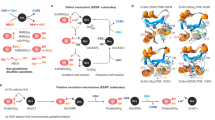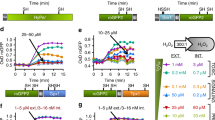Abstract
Glutathione is central to cellular redox chemistry. The majority of glutathione redox research has been based on the chemical analysis of whole-cell extracts, which unavoidably destroy subcellular compartment–specific information. Compartment-specific real-time measurements based on genetically encoded fluorescent probes now suggest that the cytosolic glutathione redox potential is about 100 mV more reducing than previously thought. Using these probes in yeast, we show that even during severe oxidative stress, the cytosolic glutathione disulfide (GSSG) concentration is much more tightly regulated than expected and provides a mechanistic explanation for the discrepancy with conventional measurements. GSSG that is not immediately reduced in the cytosol is rapidly transported into the vacuole by the ABC-C transporter Ycf1. The amount of whole-cell GSSG is entirely dependent on Ycf1 and uninformative about the cytosolic glutathione pool. Applying these insights, we identify Trx2 and Grx2 as efficient backup systems to glutathione reductase for cytosolic GSSG reduction.
This is a preview of subscription content, access via your institution
Access options
Subscribe to this journal
Receive 12 print issues and online access
$259.00 per year
only $21.58 per issue
Buy this article
- Purchase on Springer Link
- Instant access to full article PDF
Prices may be subject to local taxes which are calculated during checkout






Similar content being viewed by others
Change history
21 December 2012
In the version of this article initially published online, equation (5) in the Methods section was written incorrectly. This error has been corrected in the PDF and HTML versions of this article.
References
Kumar, C. et al. Glutathione revisited: a vital function in iron metabolism and ancillary role in thiol-redox control. EMBO J. 30, 2044–2056 (2011).
Grant, C.M., MacIver, F.H. & Dawes, I.W. Glutathione is an essential metabolite required for resistance to oxidative stress in the yeast Saccharomyces cerevisiae. Curr. Genet. 29, 511–515 (1996).
Dalle-Donne, I., Rossi, R., Colombo, G., Giustarini, D. & Milzani, A. Protein S-glutathionylation: a regulatory device from bacteria to humans. Trends Biochem. Sci. 34, 85–96 (2009).
Mieyal, J.J., Gallogly, M.M., Qanungo, S., Sabens, E.A. & Shelton, M.D. Molecular mechanisms and clinical implications of reversible protein S-glutathionylation. Antioxid. Redox Signal. 10, 1941–1988 (2008).
Muller, E.G. A glutathione reductase mutant of yeast accumulates high levels of oxidized glutathione and requires thioredoxin for growth. Mol. Biol. Cell 7, 1805–1813 (1996).
Østergaard, H., Tachibana, C. & Winther, J.R. Monitoring disulfide bond formation in the eukaryotic cytosol. J. Cell Biol. 166, 337–345 (2004).
Dooley, C.T. et al. Imaging dynamic redox changes in mammalian cells with green fluorescent protein indicators. J. Biol. Chem. 279, 22284–22293 (2004).
Gutscher, M. et al. Real-time imaging of the intracellular glutathione redox potential. Nat. Methods 5, 553–559 (2008).
Morgan, B., Sobotta, M.C. & Dick, T.P. Measuring EGSH and H2O2 with roGFP2-based redox probes. Free Radic. Biol. Med. 51, 1943–1951 (2011).
Braun, N.A., Morgan, B., Dick, T.P. & Schwappach, B. The yeast CLC protein counteracts vesicular acidification during iron starvation. J. Cell Sci. 123, 2342–2350 (2010).
Meyer, A.J. & Dick, T.P. Fluorescent protein–based redox probes. Antioxid. Redox Signal. 13, 621–650 (2010).
Albrecht, S.C., Barata, A.G., Grosshans, J., Teleman, A.A. & Dick, T.P. In vivo mapping of hydrogen peroxide and oxidized glutathione reveals chemical and regional specificity of redox homeostasis. Cell Metab. 14, 819–829 (2011).
Dardalhon, M. et al. Redox-sensitive YFP sensors monitor dynamic nuclear and cytosolic glutathione redox changes. Free Radic. Biol. Med. 52, 2254–2265 (2012).
Rebrin, I., Bayne, A.C., Mockett, R.J., Orr, W.C. & Sohal, R.S. Free aminothiols, glutathione redox state and protein mixed disulphides in aging Drosophila melanogaster. Biochem. J. 382, 131–136 (2004).
Jones, D.P. & Liang, Y. Measuring the poise of thiol/disulfide couples in vivo. Free Radic. Biol. Med. 47, 1329–1338 (2009).
Jones, D.P. Radical-free biology of oxidative stress. Am. J. Physiol. Cell Physiol. 295, C849–C868 (2008).
Schafer, F.Q. & Buettner, G.R. Redox environment of the cell as viewed through the redox state of the glutathione disulfide/glutathione couple. Free Radic. Biol. Med. 30, 1191–1212 (2001).
Aw, T.Y. Cellular redox: a modulator of intestinal epithelial cell proliferation. News Physiol. Sci. 18, 201–204 (2003).
López-Mirabal, H.R., Thorsen, M., Kielland-Brandt, M.C., Toledano, M.B. & Winther, J.R. Cytoplasmic glutathione redox status determines survival upon exposure to the thiol-oxidant 4,4′-dipyridyl disulfide. FEMS Yeast Res. 7, 391–403 (2007).
López-Mirabal, H.R. & Winther, J.R. Redox characteristics of the eukaryotic cytosol. Biochim. Biophys. Acta 1783, 629–640 (2008).
Hirrlinger, J. et al. The multidrug resistance protein MRP1 mediates the release of glutathione disulfide from rat astrocytes during oxidative stress. J. Neurochem. 76, 627–636 (2001).
Brechbuhl, H.M. et al. Glutathione transport is a unique function of the ATP-binding cassette protein ABCG2. J. Biol. Chem. 285, 16582–16587 (2010).
Lohman, J.R. & Remington, S.J. Development of a family of redox-sensitive green fluorescent protein indicators for use in relatively oxidizing subcellular environments. Biochemistry 47, 8678–8688 (2008).
Paumi, C.M., Chuk, M., Snider, J., Stagljar, I. & Michaelis, S. ABC transporters in Saccharomyces cerevisiae and their interactors: new technology advances the biology of the ABCC (MRP) subfamily. Microbiol. Mol. Biol. Rev. 73, 577–593 (2009).
Paumi, C.M., Pickin, K.A., Jarrar, R., Herren, C.K. & Cowley, S.T. Ycf1p attenuates basal level oxidative stress response in Saccharomyces cerevisiae. FEBS Lett. 586, 847–853 (2012).
Lee, M.E. et al. The Rho1 GTPase acts together with a vacuolar glutathione S-conjugate transporter to protect yeast cells from oxidative stress. Genetics 188, 859–870 (2011).
Lazard, M. et al. Selenodiglutathione uptake by the Saccharomyces cerevisiae vacuolar ATP-binding cassette transporter Ycf1p. FEBS J. 278, 4112–4121 (2011).
Tan, S.X. et al. The thioredoxin-thioredoxin reductase system can function in vivo as an alternative system to reduce oxidized glutathione in Saccharomyces cerevisiae. J. Biol. Chem. 285, 6118–6126 (2010).
Marty, L. et al. The NADPH-dependent thioredoxin system constitutes a functional backup for cytosolic glutathione reductase in Arabidopsis. Proc. Natl. Acad. Sci. USA 106, 9109–9114 (2009).
Kanzok, S.M. et al. Substitution of the thioredoxin system for glutathione reductase in Drosophila melanogaster. Science 291, 643–646 (2001).
Bonilla, M., Denicola, A., Marino, S.M., Gladyshev, V.N. & Salinas, G. Linked thioredoxin-glutathione systems in platyhelminth parasites: alternative pathways for glutathione reduction and deglutathionylation. J. Biol. Chem. 286, 4959–4967 (2011).
Porras, P. et al. Glutaredoxins catalyze the reduction of glutathione by dihydrolipoamide with high efficiency. Biochem. Biophys. Res. Commun. 295, 1046–1051 (2002).
Johansson, C., Lillig, C.H. & Holmgren, A. Human mitochondrial glutaredoxin reduces S-glutathionylated proteins with high affinity accepting electrons from either glutathione or thioredoxin reductase. J. Biol. Chem. 279, 7537–7543 (2004).
Minich, T. et al. The multidrug resistance protein 1 (Mrp1), but not Mrp5, mediates export of glutathione and glutathione disulfide from brain astrocytes. J. Neurochem. 97, 373–384 (2006).
Dringen, R. Metabolism and functions of glutathione in brain. Prog. Neurobiol. 62, 649–671 (2000).
Knollema, S., Hom, H.W., Schirmer, H., Korf, J. & Ter Horst, G.J. Immunolocalization of glutathione reductase in the murine brain. J. Comp. Neurol. 373, 157–172 (1996).
Bao, R., Zhang, Y., Lou, X., Zhou, C.Z. & Chen, Y. Structural and kinetic analysis of Saccharomyces cerevisiae thioredoxin Trx1: implications for the catalytic mechanism of GSSG reduced by the thioredoxin system. Biochim. Biophys. Acta 1794, 1218–1223 (2009).
Bulger, J.E. & Brandt, K.G. Yeast glutathione reductase. I. Spectrophotometric and kinetic studies of its interaction with reduced nicotinamide adenine dinucleotide. J. Biol. Chem. 246, 5570–5577 (1971).
Janke, C. et al. A versatile toolbox for PCR-based tagging of yeast genes: new fluorescent proteins, more markers and promoter substitution cassettes. Yeast 21, 947–962 (2004).
Rahman, I., Kode, A. & Biswas, S.K. Assay for quantitative determination of glutathione and glutathione disulfide levels using enzymatic recycling method. Nat. Protoc. 1, 3159–3165 (2006).
Meyer, A.J. et al. Redox-sensitive GFP in Arabidopsis thaliana is a quantitative biosensor for the redox potential of the cellular glutathione redox buffer. Plant J. 52, 973–986 (2007).
Mumberg, D., Muller, R. & Funk, M. Yeast vectors for the controlled expression of heterologous proteins in different genetic backgrounds. Gene 156, 119–122 (1995).
Acknowledgements
B.M. was funded by a European Molecular Biology Organization short-term fellowship (313-2009) and a DKFZ visiting scientist fellowship. Support by the Chica and Heinz Schaller Foundation is gratefully acknowledged. We thank B. Schwappach for critical reading of the manuscript.
Author information
Authors and Affiliations
Contributions
B.M., D.E. and T.N.E.A. performed all experiments. J.R. and M.S. provided materials and technical expertise, and contributed to experimental design. T.P.D. and B.M. conceived the project, analyzed the data and wrote the manuscript.
Corresponding author
Ethics declarations
Competing interests
The authors declare no competing financial interests.
Supplementary information
Supplementary Text and Figures
Supplementary Results (PDF 1144 kb)
Rights and permissions
About this article
Cite this article
Morgan, B., Ezeriņa, D., Amoako, T. et al. Multiple glutathione disulfide removal pathways mediate cytosolic redox homeostasis. Nat Chem Biol 9, 119–125 (2013). https://doi.org/10.1038/nchembio.1142
Received:
Accepted:
Published:
Issue Date:
DOI: https://doi.org/10.1038/nchembio.1142
This article is cited by
-
Deciphering the mechanism of glutaredoxin-catalyzed roGFP2 redox sensing reveals a ternary complex with glutathione for protein disulfide reduction
Nature Communications (2024)
-
PM2.5 exposure increases dry eye disease risks through corneal epithelial inflammation and mitochondrial dysfunctions
Cell Biology and Toxicology (2023)
-
Endogenous formaldehyde scavenges cellular glutathione resulting in redox disruption and cytotoxicity
Nature Communications (2022)
-
The protective role of intracellular glutathione in Saccharomyces cerevisiae during lignocellulosic ethanol production
AMB Express (2020)
-
Quantitative assessment of the determinant structural differences between redox-active and inactive glutaredoxins
Nature Communications (2020)



